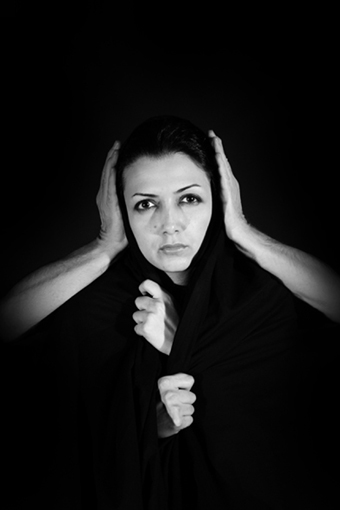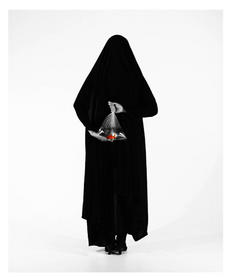identity & mutability
 |
Nasim Nasr |
shifting incarnationsNasim Nasr’s art is about identity—her own in a new culture and how it is always changeable. “I see identity as a transient invention,” she says, “it changes with time and place.” Nasim is an Iranian artist completing a Master of Visual Arts degree at the University of South Australia and one of the two exhibitions required for her degree, Rebirth, is showing at Nexus Multicultural Arts Centre until July 1. rebirthThe name of the Nexus exhibition is also that of Forugh Farrokhzad's 1959 poem Rebirth (or Another Birth), banned after the 1979 revolution. This poem is a touchstone for Nasr. In the Contemporary Art Centre of South Australia’s 2010 New New exhibition she showed Erasure, a split-screen video work depicting in one frame a chador-clad woman writing Farrokhzad’s text with chalk in English and Farsi on a chador and then erasing it and, in the other frame, a woman’s hand writing the same text in Farsi while another woman’s hand erases it, suggesting self-censorship and censorship respectively. The continuous writing and erasure represents the presence and then the disappearance of woman, the erasure of her native Farsi by the English language and the consequent erasure of her old identity. The chador in the video becomes a palimpsest bearing the retrieval and then erasure of Farrokhzad. Rebirth is also the title of a work within the Nexus exhibition—a rear view photograph of the artist in a chador, holding a goldfish in a clear plastic bag of water behind her back. In Persia, the goldfish is a symbol of the rebirth of women and a traditional New Year’s gift, and she holds it as if it she is about to surprise someone with it. In the corner of the Nexus gallery is a real goldfish in a bowl, suggesting that Nasr is born anew in this space. Nasr says in the exhibition catalogue, “This exhibition Rebirth addresses the transient identity that exists between shadow and light, past and present, and presents a response to the concept and condition presented by the ‘veiling’ of women in Islamic societies as a form of gender separation.” She particularly addresses the question of what it’s like in a western context to be covered, and says, “I want to read the image of a woman covered in black.” She creates a telling play on words by substituting ‘shadow’ for ‘chador.' mutenessIn the video Muteness the artist again uses a split-screen. In one frame, the artist is playing a daf, a large tambourine-like frame drum which originated in ancient Persia and which has been forbidden to women since the 1979 revolution. In the other, a group of men are playing dafs but are shown in slow motion, creating a disjunction between the narratives and separating the genders in time and space. The Nexus gallery walls have been painted black and the ceiling is white. The photographs generally appear in black and white, with bold white borders that set off the imagery against the black walls, and this stark theme of the co-dependency of shadow and light permeates Nasr’s work. But three brightly lit dafs hang from a lighting batten just above visitors’ heads and, with the goldfish bowl, add refreshing colour and life to the gallery. The fish in the Rebirth photograph is its natural red, the only colouring apparent in that image. liberationThe artist also appears in the three images that make up Liberation, depicting the three wise monkeys’ traditional ‘hear no evil, see no evil, speak no evil’ that asks us to ignore something unpalatable, or to be of good mind, speech and action. The hands covering her eyes, ears and mouth are not hers but the controlling, veiling hands of male power, and her response is deliberately ambivalent. In earlier photographic works Nasr projects another traditional Persian motif, the paisley design, onto images of women. Paisley, or botteh jegheh, represents the cypress tree and symbolises fertility, freedom, paradise and eternal life. In contemporary Iran, the traditional tattooing of women with this design is now banned. Nasr combines performance, photography, installation, video and traditional objects and designs into an eloquent language to map her own changing identity. In juxtaposing elements of four cultures—ancient Persia, pre-revolutionary Iran, contemporary Islamic Iran and globalised Australia—she considers the nature and function of identity, the role of women (and implicitly men) and the honouring of particular traditions. She reclaims elements of her Persian culture and, through making art, especially reclaims women’s right to speak, be recognised and seek liberation. Such liberation involves self-awareness and the viewpoint Nasr projects is her own, as she articulates her journey and adroitly employs her artistic language for cultural analysis. Presenting the personal as political is a powerful feminist strategy in this context. She concludes in the Nexus catalogue, “Rebirth thus confronts the truth behind the shadow and the recognition of woman as ‘Other’. It raises negative connotations of black and darkness to discover the source of the shadow, and light beyond that. Shadow does not exist if there is no light. Light will not be comprehensible and desirable if there is no shadow and darkness.” women in shadowNasr's Women in Shadow performance at the Australian Experimental Art Foundation on June 24 will take the form of a fashion parade, but with the models in chadors. There are no fashion parades in Iran and she states in the AEAF preview, “Whereas it is commonly understood that haute couture fashion parades are overt and highly elaborate techno/theatrical events showcasing a designer’s new series of outfits illustrating a grand statement, this performance presents a cross-cultural dialogue through looking at ‘women as Other,' erasing signs of a specific personal identity and character.” There are lessons in Nasim Nasr's work for all cultures as clothing inevitably structures identity and role. “My work is a cross-cultural dialogue,” she says, noting that some people could not be liberated even if they found themselves in a culture without rules. She states that Women in Shadow can be seen as seeking an honest and deeper understanding and desire for resolution rather than a solution. Chris Reid |
 |
Nasim NasrNasim Nasr, Rebirth, Nexus Multicultural Arts Centre, Human Rights Art and Film Festival, Adelaide, May 26-July 1; Women in Shadow, Australian Experimental Art Foundation, Adelaide, June 24. She has also been selected to show in the Boston Biennial Project at the Venice Biennale in 2011. www.nasimnasr.com |








 back
back